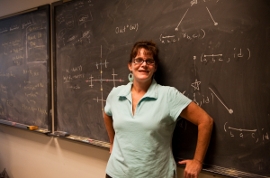Math for Real Life
By Helene Ragovin
Students learn to crunch the numbers on necessities

“Some students have a disconnect between the math they learn in math class and the math they see in the real world,” says Kim Ruane. “I wanted people not to have that fear about seeing math in the real world.” Photo: Alonso Nichols
When is the last time you balanced your checkbook? Do you understand how your credit card company figures your monthly finance charge? Is it a better deal to buy or lease a new car?
For too many people, mastering the math—and mustering the courage—to tackle such computations is daunting. And yet those transactions are the basis of our financial well-being.
Students in Kim Ruane’s summer class, Financial Mathematics, learn to conquer queasiness about using math to navigate the world of personal finance. The course uses common experiences—buying a car, reading the back of a credit card statement, saving for retirement—to refine students’ mathematical skills and to demystify the world of dollar signs and decimal points.
“These are not hard math questions, but it’s about understanding how to use the right formula or use the right calculations,” says Ruane, an associate professor of mathematics in the School of Arts and Sciences. “That’s something most people don’t think about.”
The course, which is not intended for math majors, “puts math in a context that reaches a broader group of people,” says Ruane, whose area of research is geometric group theory.
She developed the course “as a way to satisfy the A&S math requirement that would be a little more useful to a broader audience than, say, a calculus class, or even a lower-level statistics class. It’s something that would actually promote more discussion in the classroom that wasn’t necessarily mathematical and develop a different dynamic.” Some of the material for the class projects was inspired by professors at St. Michael’s College in Vermont, Ruane said.
Particularly in light of the economic downturn, “I knew students would be interested in it; everybody has credit cards; everybody buys cars and houses,” Ruane says. “I also realized that some students have a disconnect between the math they learn in math class and the math they see in the real world. I wanted people not to have that fear about seeing math in the real world.”
Buy or Lease?
The class centers around three major projects, involving credit cards, car buying and fundraising. In the future, Ruane says, she may add a component dealing with student education loans. What all these functions have in common, she says, is the need for quantitative analysis and knowing where to apply the math.
“Most people never ever read the back of their credit card statement,” she says. “That’s one of the reasons I chose that project—to get people to read it.” Based on actual credit card statements (with identifying information deleted), the students are asked to figure out the monthly finance charges and daily balances, among other things. “Everything that’s printed on there, you should be able to figure it out yourself,” Ruane says.
“It always causes controversy, every time we do that project,” Ruane says, because of the vague language employed by the banks. “There is a lot of ambiguity in the wording. We call the credit card company to get verification. It becomes something we want to understand.”
For the car-buying project, Ruane has the students presume they are going to buy a particular automobile and analyze two different finance plans: buying the car with a five-year loan, or leasing it for three years and then buying with a two-year loan. “The way I have it set up, the difference in cost is not that much,” Ruane says. She asks the students to take other factors into account, and grades them on the effectiveness of their arguments.
That format, in itself, helps foster confidence and competence in the students. “For most of these kids, their strength is verbal, so when they do the projects, they express themselves very well,” Ruane says. “It’s a mix of words and math, and you’re putting somebody in a position where you’re actually playing on their strengths.”
That approach to teaching math isn’t limited to those with verbal abilities, Ruane says.
“You can switch the topics: for instance, you could teach trigonometry in the context of building something. You can pick some context to put the math in,” Ruane says. “Courses like that make people realize, ‘Hey, I actually did understand a little bit of math from high school.’ ”
Helene Ragovin can be reached at helene.ragovin@tufts.edu.
